RESEARCH ARTICLE
Determinants of Hospital Choice among Patients and Perceptions of the Same among Hospital Employees in a Tertiary Care Corporate Hospital in Mumbai, India
Swati Singh1, Vani Lakshmi2, G Somu3, Rajesh Kamath1, *
Article Information
Identifiers and Pagination:
Year: 2022Volume: 15
E-location ID: e187494452212050
Publisher ID: e187494452212050
DOI: 10.2174/18749445-v15-e221205-2022-126
Article History:
Received Date: 19/8/2022Revision Received Date: 24/11/2022
Acceptance Date: 30/11/2022
Electronic publication date: 20/12/2022
Collection year: 2022

open-access license: This is an open access article distributed under the terms of the Creative Commons Attribution 4.0 International Public License (CC-BY 4.0), a copy of which is available at: https://creativecommons.org/licenses/by/4.0/legalcode. This license permits unrestricted use, distribution, and reproduction in any medium, provided the original author and source are credited.
Abstract
Introduction:
In recent times, the choice has become an important factor in healthcare as patients can compare hospitals and healthcare providers using the abundance of information at their disposal. Patients now want to be more involved in their treatment decision-making process and at times seek information about their conditions as well as different types of available treatment options. This makes them aware consumers. They hold the key to the domain of healthcare marketing and the best way to understand patients’ expectations is to understand the factors that affect their decision-making process.
Methods:
The prospective observational study was conducted on 252 patients and 56 employees of a tertiary care corporate hospital in Mumbai, using a structured questionnaire.
Results:
This study highlights the major factors that affect patients’ decisions when it comes to selecting a hospital. These factors are competent medical and support staff, emergency and laboratory services, the reputation of the hospital among the public, cost of services, hospital location and infrastructure. Looking at the same situation from an administrative employee’s perspective gives us an insight into how they think patients decide on a hospital.
Discussion:
The significance of this study is derived from this need of exploring the concept of patient choice from not only the consumer’s (patients’) perspective but service providers (employees) too. Patient choice factors and the service response to those factors form an important part of the patient experience with a provider, thus impacting their satisfaction.
Conclusion:
The study thus sheds light on the way patients select a hospital and the measures the hospital administration needs to take to increase their acceptance by the patients, leading to greater patient satisfaction and hence patient loyalty.
1. INTRODUCTION
Rapid advances in medical science recently and the growth in technologies in the healthcare domain along with the increase in health literacy and awareness amongst the public have led to higher expectations of the services provided by the hospital [1]. Patients now want to be more involved in their treatment decision-making process and at times seek information about their conditions as well as different types of available treatment options. This makes them aware consumers. Understanding the potential consumers of products or services is critical to the long-term success of the company. The same applies to hospitals too. Knowing the consumer is critical for hospital administrators as they attempt to adapt to rising costs, constantly changing regulation, and an increasingly competitive environment, all of which affect the occupancy rate and long-term survival of hospitals [2, 3]. In recent times, choice has become an important factor in healthcare as patients can compare hospitals and healthcare providers using the abundance of information at their disposal. In a developing country like India, where access to publicly funded healthcare facilities is difficult due to the lack of infrastructure, manpower, and other resources, patients are left with no choice but to turn to private healthcare providers. Comparing the public and private healthcare providers in the country, as of 2020, the country had 43486 private hospitals accounting for 11.8 lakh beds, in contrast to the 25778 public hospitals with a total of 7.14 lakh beds [4, 5]. Around 2013, the private health-related expenditure per capita purchasing power parity (PPP) saw a significant increase and has maintained a constant growth rate ever since pointing to the affluence of healthcare consumers.
When consumers make a choice, they assign a value to the product or service being provided that they are ready to pay for. This value is based on several factors and the expectations of the consumer. The choice is only made when a certain product or service provider lives up to the importance of these factors and fulfills the consumer's expectations. In a hospital scenario, this results in choosing a hospital’s quality of care based on factors that may range from affordable pricing of the services to the availability of doctors. The factors that affect patient choice are essential to highlight consumer demand and are important in market research [6, 7]. Patients’ choices and decision-making influence patient empowerment. It results in better service delivery outcomes and impacts overall health behavior. An empowered consumer makes better decisions by acting upon available choices [8]. Promoting patient choice can improve health outcomes and non-health-related outcomes like trust and economic benefit [9].
Several studies were conducted worldwide to assess the information needed by patients to make healthcare choices and the factors considered while selecting hospitals for treatment. These factors include service delivery, experience, price, value architecture influence, health literacy, self-efficacy, and awareness [10, 11]. Patient choice was conceptualized in developed countries as a tool to reduce waiting time. A study found that there was a small but significant reduction in the waiting time post the introduction of the concept of choice. It identified the effect of choice and waiting time on the demand for healthcare services of National Health Services [12, 13], [14]. “Preference diagnosis” refers to the assumptions made by healthcare providers about patient preferences. Closer the preference diagnosis, patients are proven to consume less healthcare [15]. India has low health awareness and literacy. There is inadequate literature on the factors affecting patient choice. Analyzing these factors will help to develop healthcare insurance policies and to achieve universal health coverage. This study is thus significant as it explores the concept of patient choice in the urban Indian context.
Patient choice factors and the service response to those factors form an important part of the patient experience with a provider, thus impacting their satisfaction [16, 17]. It is also important to understand that delivering patient expectations will give rise to an increase in patient satisfaction and will ultimately lead to an increase in revenue for the hospitals. It is thereby important for hospital administrators to offer services based on patient expectations [18].
2. METHODOLOGY
2.1. Study Design
A prospective observational study was done on 252 patients and 56 employees of a tertiary care corporate hospital in urban Maharashtra, who were chosen using a purposive sampling method. Study group-specific structured questionnaire was administered to both groups of participants and the data collected was analyzed to assess the key factors that lead to the choice of a certain hospital. The questionnaire was designed based on a similar study conducted in Udaipur by Motwani and Shrimali [19].
2.2. Inclusion Criteria
Patients attending the out-patient department for the first time and the employees working in administrative positions were included.
2.3. Exclusion Criteria
Follow-up patients, clinical staff, nursing staff, and support service staff were excluded from this study. Sources of bias were eliminated through purposive sampling. No kith or kin associated with the hospital or the interviewer was included. Anyone with a legal battle against the hospital administration was excluded.
2.4. Sample Size
Responses from 252 patients/caregivers and 56 employees were collected using a purposive sampling approach.
2.5. Method of Data Collection
The study was done on patients and employees (managerial and administrative positions only) at a tertiary care corporate hospital in urban Maharashtra using a structured questionnaire during March and April 2022. The questionnaire was designed based on a similar study conducted in Udaipur by Motwani and Shrimali [19]. Due permission was taken from the authors to use the same. In the first section, consent was taken from the participants for their responses to be used in the study. In the second section, there were eight questions pertaining to the sociodemographic factors that belong to participants. For collecting the sociodemographic data pertaining to the employees (for objective 2), the second section had only four questions. For the third section, eighteen decisive variables were listed, and participants were to grade the importance of these variables in hospital selection in the range of very important to least important, using a five-point Likert scale. For the questionnaire for employees, the participants were to grade the same eighteen decisive variables as an answer to how important these are to patients choosing their hospital in the range of very important to least important, using a five-point Likert scale. The questionnaires used are attached in Annexure. It is the data from the third section was used to assess and identify the key factors associated with hospital choices. This study highlights the major factors that affect patients’ decisions when it comes to selecting a hospital. These factors are competent medical and support staff, emergency and laboratory services, the reputation of the hospital among the public, cost of services, hospital location, and infrastructure. Looking at the same situation from an administrative employee’s perspective gives us an insight into how they think patients decide a hospital.
3. RESULTS
The results of the study can be broadly divided into two major sections:
1. Patient Perspective
2. Employees perspective
Under these headings, the results are divided into the following sub-sections:
1. Sociodemographic analysis of the participants
2. Results of the questionnaire
3. Factor Rankings
Descriptive statistics i.e., frequency and weighted average, were calculated. Factor Ranking was done using Microsoft Excel 365.
3.1. Patient Perspective
A total of 252 responses were collected from patients in the Outpatient Department (OPD) and In-Patient Department (IPD). The following are the results of the questionnaire administered.
3.3. Results of the Questionnaire
The responses to the 3rd section of the questionnaire were compiled, wherein the participants were asked 2 questions:
(a) In the first question, the participants were asked to grade the importance of the decisive variables mentioned, when it comes to choosing a hospital in general on a five-point Likert’s scale.
(b) In the second question, the participants were asked to choose the variables that led to them choosing the hospital of study.
The responses to the first question are compiled and represented below in Table 1.
The most important variables for the study group were as follows:
(a) Qualified and experienced doctors.
(b) Trained Nursing staff
(c) 24X7 Emergency Services
(d) Modern Laboratory and Equipment
(e) Positive word of the mouth.
3.4. Factor Rankings: Patient Perspective
Weighted averages were calculated for all the decisive variables (Table 2). The results showed that the highest weighted averages were the same variables that were deemed ‘Most Important’ by most of the participants namely, ‘Qualified and experienced doctors’(82.67), ‘Trained nursing staff’ (82.07), ‘24X7 Emergency services’ (78.60), ‘Modern laboratory and equipment’ (78.47), ‘Positive word of mouth’ (78.0). This was followed by the variables ‘Fast and hassle-free billing’ (75.47), ‘Affordable prices’ (75.33), ‘Location and Accessibility’ (75.0), ‘Infrastructure and physical facilities’ (74.73), ‘Cashless and digital payment options’ (74.07), ‘Past experience with the hospital’ (73.07), ‘Least Waiting Time’ (72.07), ‘Online appointment System and telemedicine’ (70.73) respectively. The remaining four variables had a weighted average of <70.0 and hence we can consider them to have the least impact on hospital selection. These variables were, ‘Patient education and treatment outcomes’ (69.73), ‘Insurance coverage’ (69.13), ‘In-house pharmacy facility’ (66.73) and ‘Brand name of the hospital’ (56.60), respectively.
3.7. Results of the Questionnaire
The 56 responses of the 3rd section of the questionnaire were compiled, wherein the participants were asked to grade the importance of the mentioned components to the patients visiting the hospital on a five-point Likert’s scale. The responses are compiled and represented below.
The most important variables for the study group are depicted in Table 3.
3.8. Factor Rankings: Employees’ Perspective
Weighted averages were calculated for all the decisive variables (Table 4). The results showed that the highest weighted averages were the same variables which were deemed ‘Most Important’ by most of the participants namely, ‘Qualified and experienced doctors’ (18.13), ‘Trained nursing staff’ (17.80), ‘24X7 Emergency services’ (17.53), ‘Insurance coverage’ (17.53), ‘Modern laboratory and equipment’ (17.40), ‘Infrastructure and physical facilities’ (16.93), ‘Cashless/Digital payments’ (16.80), and ‘Brand name of the hospital’ (16.73). This was followed by the variables ‘Past experience with the hospital’ (16.73), ‘Online appointment System and telemedicine’ (16.40), ‘Courteous and friendly support staff’ (16.20), ‘In-house pharmacy facility’ (16.20), ‘Positive word of the mouth’ (16.07) respectively. A similar study conducted in Bilaspur, Chhattisgarh highlighted that punctuality of staff, publicity, accessibility, 24-hour outdoor services, quick admission, infrastructure, expertise, etiquettes of doctors, confidentiality were the most important variables for choosing hospital services [20]. The remaining five variables had weighted average of <16.0 and hence we can consider them to have the least impact on hospital selection. These variables were, ‘Patient education and treatment outcomes’ (15.67), ‘Location and accessibility’ (15.60), ‘Affordable prices’ (14.87), ‘Least waiting time’ (13.67) and ‘Fast and hassle-free billing’ (13.20), respectively.
| S. No. | Decisive Variables | Most Important | Important | Moderately Important | Less Important | Least Important |
| 1 | Affordable Prices | 58% | 34% | 8% | 1% | 0% |
| 2 | Location and Accessibility | 55% | 38% | 6% | 1% | 0% |
| 3 | Brand name of the Hospital | 24% | 22% | 28% | 19% | 7% |
| 4 | Past experience with the hospital | 46% | 45% | 6% | 2% | 0% |
| 5 | 24X7 Emergency services | 72% | 25% | 2% | 0% | 0% |
| 6 | Qualified and experienced doctors | 93% | 6% | 0% | 0% | 0% |
| 7 | Trained nursing staff | 90% | 10% | 0% | 0% | 0% |
| 8 | Patient education and explanation of treatment outcomes | 42% | 34% | 23% | 1% | 0% |
| 9 | Courteous and friendly support staff | 50% | 48% | 2% | 0% | 0% |
| 10 | Insurance coverage | 56% | 25% | 4% | 7% | 9% |
| 11 | Least waiting time | 39% | 52% | 9% | 0% | 0% |
| 12 | Modern laboratory and equipment | 69% | 29% | 2% | 0% | 0% |
| 13 | In-house pharmacy facility | 32% | 35% | 31% | 2% | 0% |
| 14 | Infrastructure and physical facility | 51% | 44% | 5% | 0% | 0% |
| 15 | Positive word of mouth | 68% | 29% | 2% | 1% | 0% |
| 16 | Fast and hassle free billing | 53% | 44% | 3% | 0% | 0% |
| 17 | Cashless/Digital payment options | 50% | 41% | 8% | 1% | 0% |
| 18 | Online appointment system and telemedicine | 40% | 44% | 14% | 1% | 1% |
| S. No. | Weights | 5 | 4 | 3 | 2 | 1 | Total | Weighted Total | Weighted Average | Rank |
| Importance | Most Important | Important | Moderately Important | Less Important | Least Important | |||||
| Decisive Variables | ||||||||||
| 1 | Affordable Prices | 145 | 86 | 19 | 2 | 0 | 252 | 1130 | 75.33 | 7 |
| 2 | Location and Accessibility | 138 | 96 | 15 | 3 | 0 | 252 | 1125 | 75.00 | 9 |
| 3 | Brand name of the Hospital | 60 | 56 | 70 | 49 | 17 | 252 | 849 | 56.60 | 18 |
| 4 | Past experience with the hospital | 117 | 114 | 14 | 6 | 1 | 252 | 1096 | 73.07 | 12 |
| 5 | 24X7 Emergency services | 181 | 64 | 5 | 1 | 1 | 252 | 1179 | 78.60 | 3 |
| 6 | Qualified and experienced doctors | 235 | 16 | 0 | 0 | 1 | 252 | 1240 | 82.67 | 1 |
| 7 | Trained nursing staff | 226 | 25 | 0 | 0 | 1 | 252 | 1231 | 82.07 | 2 |
| 8 | Patient education and explanation of treatment outcomes | 105 | 85 | 58 | 3 | 1 | 252 | 1046 | 69.73 | 15 |
| 9 | Courteous and friendly support staff | 127 | 120 | 4 | 0 | 1 | 252 | 1128 | 75.20 | 8 |
| 10 | Insurance coverage | 140 | 63 | 9 | 18 | 22 | 252 | 1037 | 69.13 | 16 |
| 11 | Least waiting time | 98 | 130 | 23 | 1 | 0 | 252 | 1081 | 72.07 | 13 |
| 12 | Modern laboratory and equipment | 174 | 73 | 5 | 0 | 0 | 252 | 1177 | 78.47 | 4 |
| 13 | In-house pharmacy facility | 80 | 89 | 79 | 4 | 0 | 252 | 1001 | 66.73 | 17 |
| 14 | Infrastructure and physical facility | 128 | 110 | 13 | 1 | 0 | 252 | 1121 | 74.73 | 10 |
| 15 | Positive word of mouth | 172 | 72 | 6 | 2 | 0 | 252 | 1170 | 78.00 | 5 |
| 16 | Fast and hassle-free billing | 133 | 111 | 7 | 1 | 0 | 252 | 1132 | 75.47 | 6 |
| 17 | Cashless/Digital payment options | 127 | 103 | 20 | 2 | 0 | 252 | 1111 | 74.07 | 11 |
| 18 | Online appointment system and telemedicine | 101 | 110 | 36 | 3 | 2 | 252 | 1061 | 70.73 | 14 |
| S. No. | Decisive Variables | Most Important | Important | Moderately Important | Less Important | Least Important |
|---|---|---|---|---|---|---|
| 1 | Affordable Prices | 39% | 27% | 29% | 4% | 2% |
| 2 | Location and Accessibility | 45% | 32% | 20% | 4% | 0% |
| 3 | Brand name of the Hospital | 61% | 29% | 9% | 2% | 0% |
| 4 | Past experience with the hospital | 54% | 41% | 5% | 0% | 0% |
| 5 | 24X7 Emergency services | 71% | 27% | 2% | 0% | 0% |
| 6 | Qualified and experienced doctors | 86% | 14% | 0% | 0% | 0% |
| 7 | Trained nursing staff | 79% | 20% | 2% | 0% | 0% |
| 8 | Patient education and explanation of treatment outcomes | 38% | 45% | 18% | 0% | 0% |
| 9 | Courteous and friendly support staff | 43% | 48% | 9% | 0% | 0% |
| 10 | Insurance coverage | 73% | 25% | 0% | 2% | 0% |
| 11 | Least waiting time | 21% | 36% | 32% | 9% | 2% |
| 12 | Modern laboratory and equipment | 68% | 30% | 2% | 0% | 0% |
| 13 | In-house pharmacy facility | 48% | 45% | 2% | 4% | 2% |
| 14 | Infrastructure and physical facility | 61% | 32% | 7% | 0% | 0% |
| 15 | Positive word of mouth | 41% | 48% | 11% | 0% | 0% |
| 16 | Fast and hassle-free billing | 27% | 20% | 36% | 16% | 2% |
| 17 | Cashless/Digital payment options | 63% | 32% | 2% | 0% | 4% |
| 18 | Online appointment system and telemedicine | 50% | 43% | 5% | 0% | 2% |
| S. No. | Weights | 5 | 4 | 3 | 2 | 1 | Total | Weighted Total | Weighted Average | Rank |
|---|---|---|---|---|---|---|---|---|---|---|
| Importance | Most Important | Important | Moderately Important | Less Important | Least Important | |||||
| Decisive Variables | ||||||||||
| 1 | Affordable Prices | 22 | 15 | 16 | 2 | 1 | 56 | 223 | 14.87 | 16 |
| 2 | Location and Accessibility | 25 | 18 | 11 | 2 | 0 | 56 | 234 | 15.60 | 15 |
| 3 | Brand name of the Hospital | 34 | 16 | 5 | 1 | 0 | 56 | 251 | 16.73 | 8 |
| 4 | Past experience with the hospital | 30 | 23 | 3 | 0 | 0 | 56 | 251 | 16.73 | 9 |
| 5 | 24X7 Emergency services | 40 | 15 | 1 | 0 | 0 | 56 | 263 | 17.53 | 3 |
| 6 | Qualified and experienced doctors | 48 | 8 | 0 | 0 | 0 | 56 | 272 | 18.13 | 1 |
| 7 | Trained nursing staff | 44 | 11 | 1 | 0 | 0 | 56 | 267 | 17.80 | 2 |
| 8 | Patient education and explanation of treatment outcomes | 21 | 25 | 10 | 0 | 0 | 56 | 235 | 15.67 | 14 |
| 9 | Courteous and friendly support staff | 24 | 27 | 5 | 0 | 0 | 56 | 243 | 16.20 | 11 |
| 10 | Insurance coverage | 41 | 14 | 0 | 1 | 0 | 56 | 263 | 17.53 | 4 |
| 11 | Least waiting time | 12 | 20 | 18 | 5 | 1 | 56 | 205 | 13.67 | 17 |
| 12 | Modern laboratory and equipment | 38 | 17 | 1 | 0 | 0 | 56 | 261 | 17.40 | 5 |
| 13 | In-house pharmacy facility | 27 | 25 | 1 | 2 | 1 | 56 | 243 | 16.20 | 12 |
| 14 | Infrastructure and physical facility | 34 | 18 | 4 | 0 | 0 | 56 | 254 | 16.93 | 6 |
| 15 | Positive word of mouth | 23 | 27 | 6 | 0 | 0 | 56 | 241 | 16.07 | 13 |
| 16 | Fast and hassle free billing | 15 | 11 | 20 | 9 | 1 | 56 | 198 | 13.20 | 18 |
| 17 | Cashless/Digital payment options | 35 | 18 | 1 | 0 | 2 | 56 | 252 | 16.80 | 7 |
| 18 | Online appointment system and telemedicine | 28 | 24 | 3 | 0 | 1 | 56 | 246 | 16.40 | 10 |
4. DISCUSSION
This chapter deals with detailed in-depth discussions and interpretation of the results obtained from the study. The first group of participants had 252 patients has participants. 43% of them were between 36 to 55 years of age (Fig. 1) with almost equal distribution between male and female participants (52% male and 48% female participants) (Fig. 2). Most of the respondents had the education qualifications of graduation or above (83%) suggesting that most of the participants had received higher education and the decisions made by them was an informed one (Fig. 3). Around half of the participants (52%) were in the Rs. 30,000-65,000 per month range (Fig. 4). 52% of them worked in the private sector (Fig. 5). 70% of them were married (Fig. 6). 82% of the respondents had health insurance (Fig. 7), out of these insured participants, a majority (77%) were insured under private insurance (Fig. 8). Interestingly 15% of those insured were under public insurance and the hospital was not empanelled under them, hence the cost had to be borne as Out of pocket expenditure.
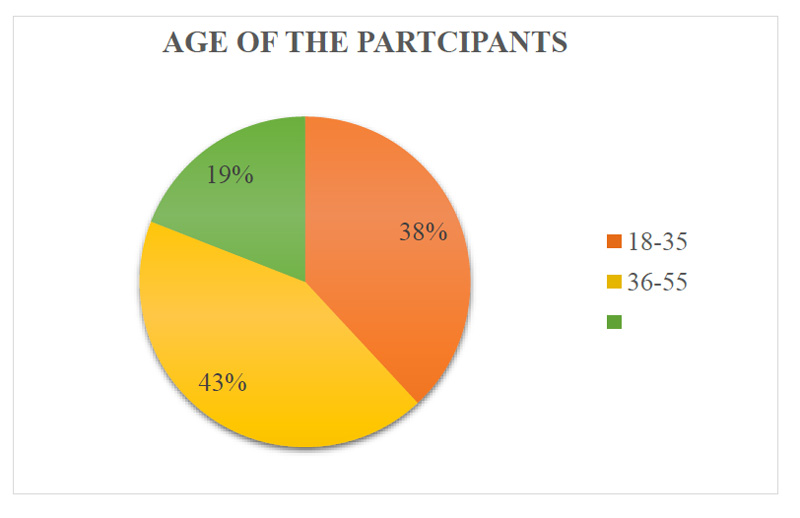 |
Fig. (1). Pie chart showing the age distribution of the participants. |
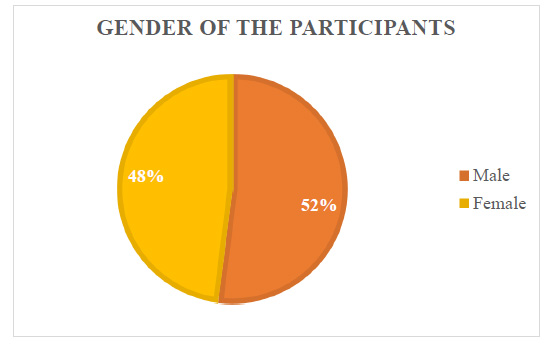 |
Fig. (2). Pie chart showing the gender distribution of the participants. |
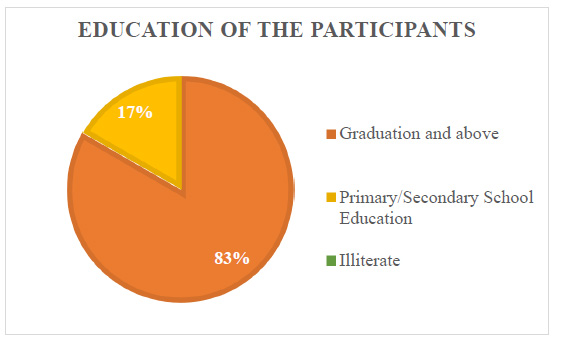 |
Fig. (3). Pie chart showing the educational distribution of the participants. |
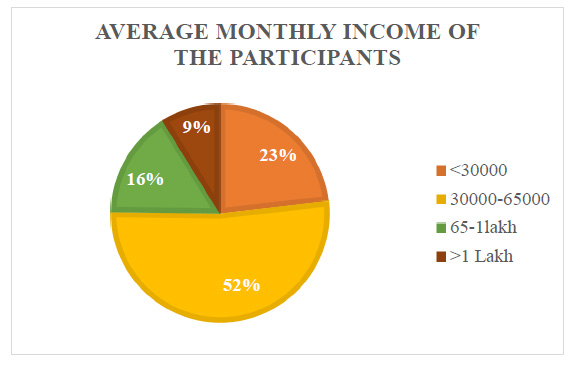 |
Fig. (4). Pie chart showing the income distribution of the participants. |
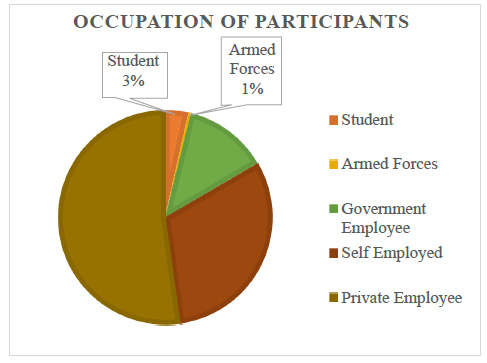 |
Fig. (5). Pie chart showing the occupational distribution of the participants. |
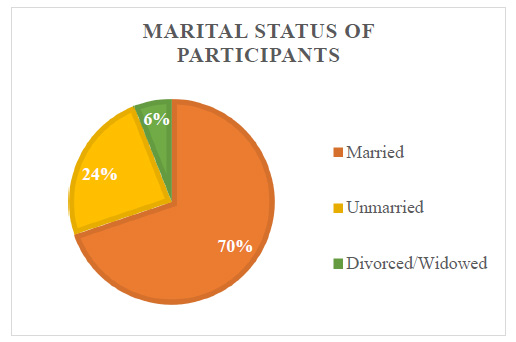 |
Fig. (6). Pie chart showing the marital status of the participants. |
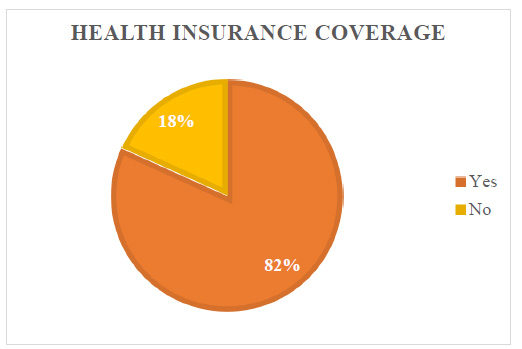 |
Fig. (7). Pie chart showing the health insurance coverage of the participants. |
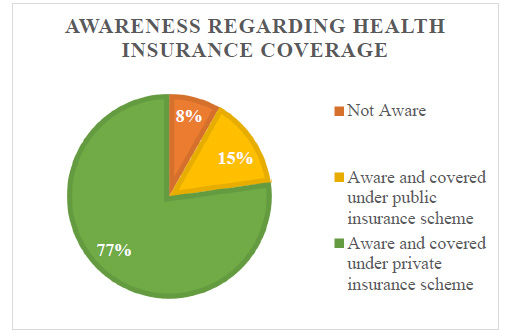 |
Fig. (8). Pie chart showing the awareness regarding health insurance of the participants. |
On investigating the obtained results of the first group (patients), it was found that the variables ‘Qualified and experienced doctors’, ‘Trained nursing staff’, ‘24X7 Emergency services’, ‘Modern laboratory and equipment’, ‘Positive word of mouth’ was deemed ‘Very Important’ by at least 60% of the respondents (Figs. 9 and 10) which is similar to the findings of the study conducted in Udaipur [19] except that in the mentioned study, positive word of mouth was deemed ‘Important’ by majority of the participants. Interestingly ‘Brand name of the hospital, was deemed ‘moderately important’ by the participants of the study. The importance of the decisive variables based on the data obtained is summarised in Table 5.
On investigating the obtained results of the second group (employees), the variables ‘Qualified and experienced doctors’, ‘Trained nursing staff’, ‘Insurance coverage’ ‘24X7 Emergency services’, ‘Modern laboratory and equipment’, ‘Cashless/Digital payments’, ‘Brand name of the hospital’ and Infrastructure and physical facilities’ was deemed ‘Very Important’ by at least 60% of the respondents. Interestingly ‘Fast and hassle-free billing’ was deemed ‘moderately important’ by the participants of the study which contrasted with responses of the first group of participants (patients) where the same variable was deemed ‘very important’ by 52.8% of the respondents (Table 5). Similar contrast was noted for the variable ‘Brand name of the hospital’ too.
Based on the weighted averages of the responses obtained, the decisive variables were ranked. Table 6 shows the decisive factors in accordance with the ranking.
The bottom five decisive variables include (in that order): ‘Online appointment system and telemedicine’, ‘Patient education and explanation of treatment outcomes’, ‘Insurance coverage’, ‘In-house pharmacy facility’ and ‘Brand name of the Hospital’. The rankings of ‘Insurance coverage’, ‘In-house pharmacy facility’ and ‘Brand name of the Hospital’ were in line with the study conducted in Udaipur [19]. On comparing the results with the same study, it was noted that while the variables ‘Qualified and experienced doctors’, ‘Trained nursing staff’, ‘24X7 Emergency services’, ‘Modern laboratory and equipment’, ‘Positive word of mouth’ had similar rankings, the variable similar to ‘Patient education and explanation of treatment outcomes’ showed contrasting results. This variable was ranked 4 in the mentioned study but was ranked 15 in our study showing that the study group of patients was more interested in receiving quality services rather than understanding the health issues and the treatment plans.
| S. No. | Decisive Variables | Importance | Count (% of total) |
|---|---|---|---|
| 1 | Affordable Prices | Very Important | 145 (57.5%) |
| 2 | Location and Accessibility | Very Important | 138 (54.8%) |
| 3 | Brand name of the Hospital | Moderately Important | 70 (27.8%) |
| 4 | Past experience with the hospital | Very Important | 117 (46.4%) |
| 5 | 24X7 Emergency services | Very Important | 181 (71.8%) |
| 6 | Qualified and experienced doctors | Very Important | 235 (93.3%) |
| 7 | Trained nursing staff | Very Important | 226 (89.7%) |
| 8 | Patient education and explanation of treatment outcomes | Very Important | 105 (41.7%) |
| 9 | Courteous and friendly support staff | Very Important | 127 (50.4%) |
| 10 | Insurance coverage | Very Important | 140 (55.6%) |
| 11 | Least waiting time | Important | 130 (51.6%) |
| 12 | Modern laboratory and equipment | Very Important | 174 (69%) |
| 13 | In-house pharmacy facility | Important | 89 (35.3%) |
| 14 | Infrastructure and physical facility | Very Important | 128 (50.8%) |
| 15 | Positive word of mouth | Very Important | 172 (68.3%) |
| 16 | Fast and hassle-free billing | Very Important | 133(52.8%) |
| 17 | Cashless/Digital payment options | Very Important | 127 (50.4%) |
| 18 | Online appointment system and telemedicine | Important | 110 (43.7%) |
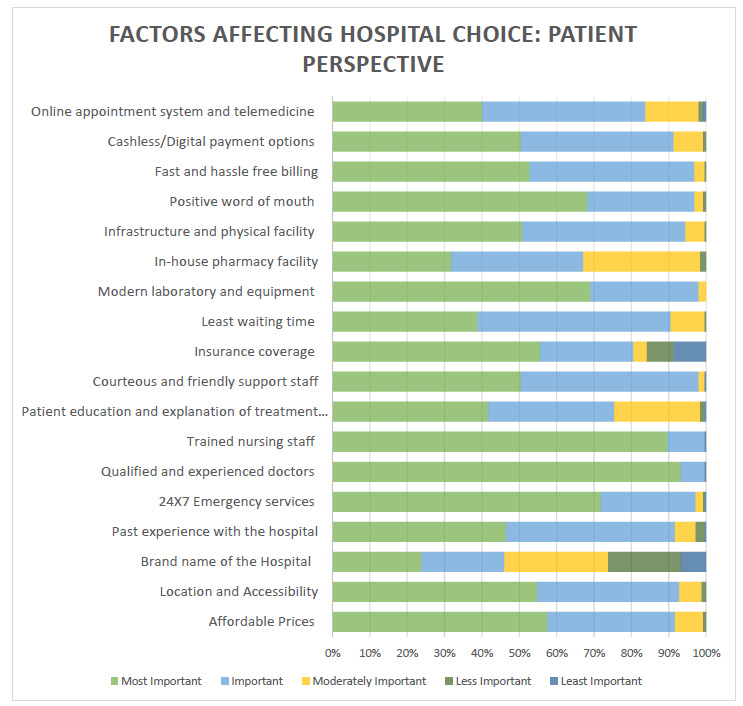 |
Fig. (9). Stacked bar chart showing the importance of the variables that affect the choice of hospitals (patient perspective). |
| Decisive Variables | Patient Perspective Ranking |
| Qualified and experienced doctors | 1 |
| Trained nursing staff | 2 |
| 24X7 Emergency services | 3 |
| Modern laboratory and equipment | 4 |
| Positive word of mouth | 5 |
| Fast and hassle-free billing | 6 |
| Affordable Prices | 7 |
| Courteous and friendly support staff | 8 |
| Location and Accessibility | 9 |
| Infrastructure and physical facility | 10 |
| Cashless/Digital payment options | 11 |
| Past experience with the hospital | 12 |
| Least waiting time | 13 |
| Online appointment system and telemedicine | 14 |
| Patient education and explanation of treatment outcomes | 15 |
| Insurance coverage | 16 |
| In-house pharmacy facility | 17 |
| Brand name of the Hospital | 18 |
When the participants of the first group (patients) were asked to choose the variables that led them to choose the hospital of study, it was noted that most patients chose the hospital for ‘Qualified and experienced doctors’ with 229 participants opting for the mentioned variable, followed by ‘Location and accessibility’ of the hospital which was chosen by 168 participants. The third important reason for choosing the hospital was observed to be ‘Insurance coverage’ with 122 participant responses. The least chosen variables were ‘Least waiting time’, ‘fast and hassle-free billing’ and ‘in-house pharmacy facility’ with counts of 22, 17 and 15, respectively pointing towards patients’ dissatisfaction with the services. The most and the least chosen variables also point to the strength and weaknesses of the hospital of study. Given below are the counts of the variables that affected the patients’ choice of hospital when it came to them choosing the hospital of study.
The second group of participants had 56 hospital employees who held administrative positions. The reason only employees holding administrative positions were chosen was because these employees form the decision-making bodies of the hospital and look after the service delivery to the patients. Most of the employees in this group (75%) were in the age group of 18-35 years (Fig. 11), implying a significantly young workforce and interestingly 66% of the participants were women (Fig. 12). 64% of them were married (Fig. 13). The importance of the decisive variables based on the data obtained is summarised in Table 7.
Based on the weighted averages of the responses obtained, the decisive variables were ranked. Table 8 shows the decisive factors in accordance with the ranking.
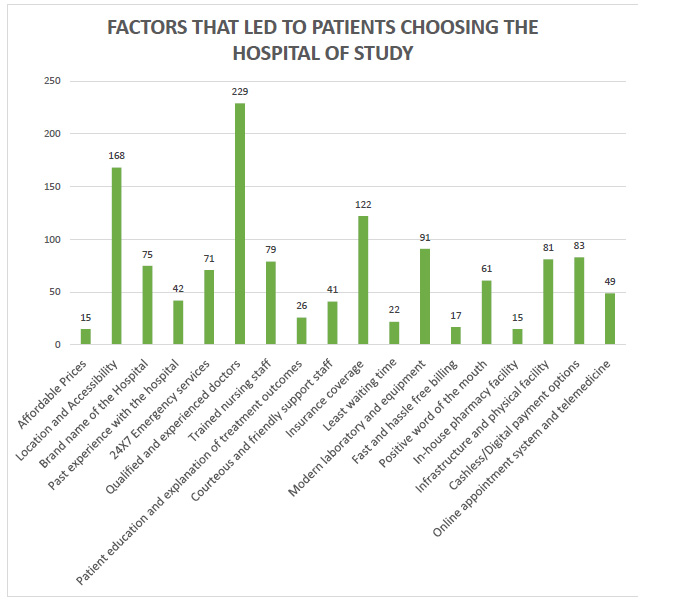 |
Fig. (10). Clustered column chart showing the variables that led the participants to choose the hospital of study. |
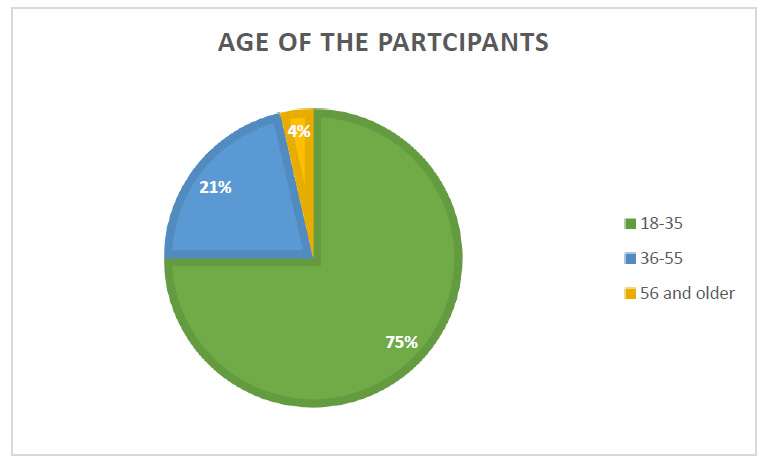 |
Fig. (11). A pie chart showing the age distribution of the participants. |
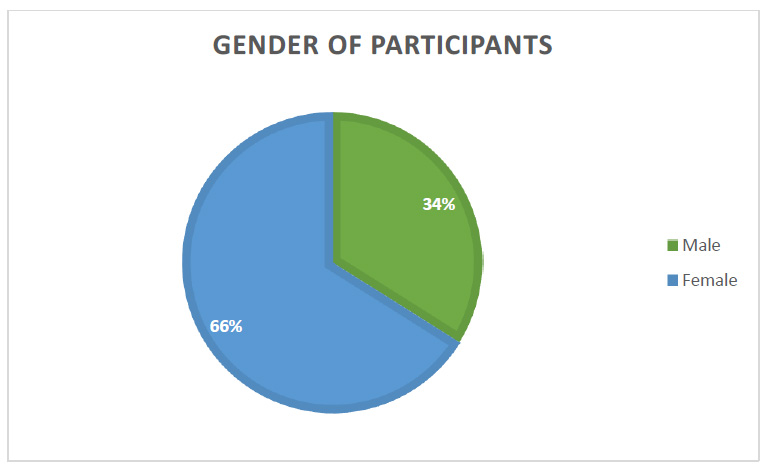 |
Fig. (12). A pie chart showing the gender distribution of the participants. |
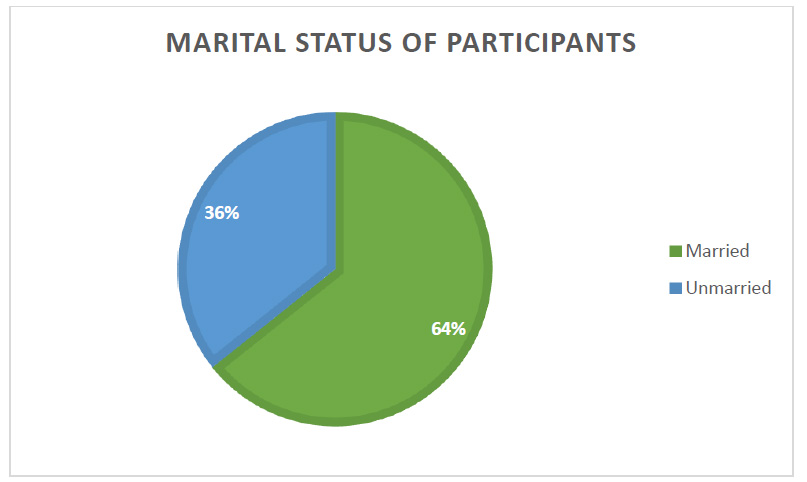 |
Fig. (13). Pie chart showing the marital status of the participants. |
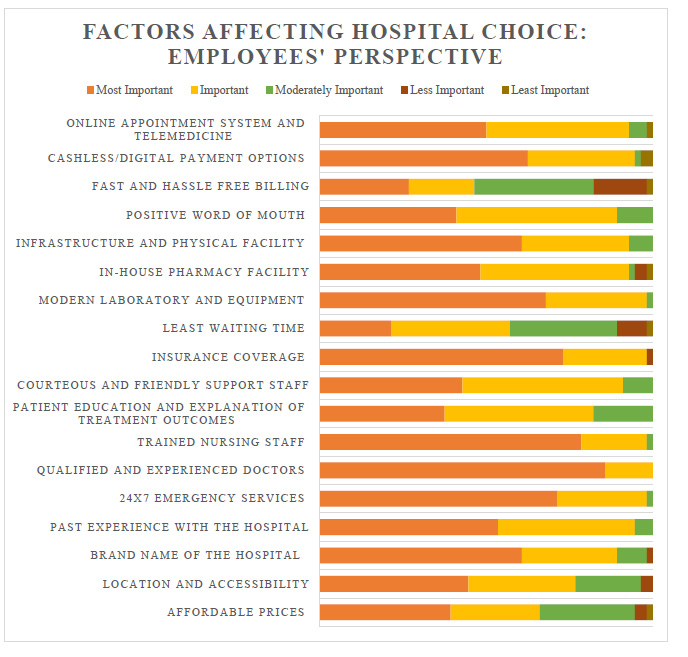 |
Fig. (14). Stacked bar chart showing the importance of the variables that affect the choice of hospital: Employees’ perspective. |
Comparisons can be now made between the rankings obtained from both the groups of participants.
Table 9 shows the variables that held the same rank from both the patients and employees’ responses. These variables are: Qualified and experienced doctors, trained nursing staff and 24X7 emergency services. These findings were consistent with some findings of another study which found that the availability of surgeons and physicians was the most important factor leading to hospital selection [21]. Similar findings were noted in the study in Udaipur as already pointed out earlier [19]. The findings of a study conducted in Riyadh also point to medical services being the major factor behind selection of a specific hospital [22]. In a study conducted in New Delhi, it was found that most of the participants chose private hospital owing to the competency of the doctors and nurses [23]. The study conducted in Tehran also showed that ‘physicians and employees’ were significant contributors to hospital selection for patients [24]. A study conducted in China showed that sufficient tests and examination, expertise of doctors and good service attitude influenced hospital choice. Low service cost was another important feature of a healthcare facility [25].
Same rankings for the factors mentioned above indicate that hospital administration considers these factors a priority as well leading to patient satisfaction and hence patients choosing the hospital over other hospitals. It is important to note that ‘qualified and experienced doctors were the major reason why the hospital was chosen by the patients. Table 10 shows the ranking difference of less than 5 between the employees’ ranking and patients’ rankings. This means that some of these variables may be important to patients but are not on the same priority for employees or the vice versa. ‘Modern laboratory and equipment’ hold almost similar ranking for both employees and patients and the patient’s response is similar to the results obtained by Heischmidt et al. [26]. Similar ranking was also noted for the variable ‘Patient education and treatment outcomes’ as well. ‘Courteous and friendly support staff’ was ranked higher by the patients as compared to the employees. The opposite was true for the variables, ‘Past experience with hospital’, ‘Infrastructure and physical facility’, ‘Cashless/Digital payment options’ and ‘Online appointment system and telemedicine’ showing that employees feel these variables prioritised by the patients when they choose a hospital but the patient responses show otherwise. It is interesting to note the ranking difference for the variable ‘Least waiting time’ which was ranked 13th by the patients but was ranked 17th by the employees, which is the penultimate rank corelating this finding with the finding in Table 10, we notice that this variable was the least chosen variable when it came to patients choosing the hospital of study. This implies that employees are aware of long waiting durations at the hospital and know that this would be amongst the last variables for the patients visiting the hospital. Long waiting durations have negative impact on patient satisfaction which will eventually lead to patients not choosing the hospital for future treatments [27] (Fig. 14).
Table 11 shows the variables with a ranking difference of more than 5. This section revealed many disparities between the priorities of patients and employees. ‘Positive word of the mouth’, ‘Fast and hassle-free billing’, ‘Affordable prices’ and ‘Location and accessibility’ was ranked 5, 6, 7 and 9, respectively by patients showing its importance in deciding their hospital of choice. The same variables were ranked 13, 18, 16 and 15, respectively by the employees implying that it may not be a priority for the patients at the hospital of study, whereas the reality was a direct contrast to this. ‘Insurance coverage’ and ‘Brand name of the hospital’ seemed to be prioritised by employees but the responses of the patients highlighted that these variables were the last on the list of things to consider while selecting a hospital. Similar finding was noted for the variable ‘In-house pharmacy’ which was ranked 12 by employees but 17 by the patients. Ease of access and cost were amongst the important variables considered by patients when it came to the selection of a hospital in the study conducted in four metro cities of India [28]. This study yielded similar results. Studies conducted in Germany, Saudi Arabia, India and China showed contrasting results that patients were willing to travel to distant hospitals to get special treatment [29-32].
| S. No. | Decisive Variables | Importance | Count (% of Total) |
|---|---|---|---|
| 1 | Affordable Prices | Very Important | 22 (39.3%) |
| 2 | Location and Accessibility | Very Important | 25 (44.6%) |
| 3 | Brand name of the Hospital | Very Important | 34 (60.7%) |
| 4 | Past experience with the hospital | Very Important | 30 (53.6%) |
| 5 | 24X7 Emergency services | Very Important | 40 (71.4%) |
| 6 | Qualified and experienced doctors | Very Important | 48 (85.7%) |
| 7 | Trained nursing staff | Very Important | 44 (78.6%) |
| 8 | Patient education and explanation of treatment outcomes | Important | 25(44.6%) |
| 9 | Courteous and friendly support staff | Important | 27 (48.2%) |
| 10 | Insurance coverage | Very Important | 41 (73.2%) |
| 11 | Least waiting time | Important | 20 (35.7%) |
| 12 | Modern laboratory and equipment | Very Important | 38 (67.9%) |
| 13 | In-house pharmacy facility | Very Important | 27 (48.2%) |
| 14 | Infrastructure and physical facility | Very Important | 34 (60.7%) |
| 15 | Positive word of mouth | Important | 27 (48.2%) |
| 16 | Fast and hassle-free billing | Moderately Important | 20 (35.7%) |
| 17 | Cashless/Digital payment options | Very Important | 35 (62.5%) |
| 18 | Online appointment system and telemedicine | Very Important | 28 (50%) |
| S. No. | Decisive variables | Employee Perspective Ranking |
|---|---|---|
| 1 | Qualified and experienced doctors | 1 |
| 2 | Trained nursing staff | 2 |
| 3 | 24X7 Emergency services | 3 |
| 4 | Insurance coverage | 4 |
| 5 | Modern laboratory and equipment | 5 |
| 6 | Infrastructure and physical facility | 6 |
| 7 | Cashless/Digital payment options | 7 |
| 8 | Brand name of the Hospital | 8 |
| 9 | Past experience with the hospital | 9 |
| 10 | Online appointment system and telemedicine | 10 |
| 11 | Courteous and friendly support staff | 11 |
| 12 | In-house pharmacy facility | 12 |
| 13 | Positive word of mouth | 13 |
| 14 | Patient education and explanation of treatment outcomes | 14 |
| 15 | Location and Accessibility | 15 |
| 16 | Affordable Prices | 16 |
| 17 | Least waiting time | 17 |
| 18 | Fast and hassle-free billing | 18 |
| S. No. | Decisive Factors | Employee Perspective Ranking | Patient Perspective Ranking |
|---|---|---|---|
| 1 | 24X7 Emergency services | 3 | 3 |
| 2 | Qualified and experienced doctors | 1 | 1 |
| 3 | Trained nursing staff | 2 | 2 |
| S. No. | Decisive Factors | Employee Perspective Ranking | Patient Perspective Ranking |
|---|---|---|---|
| 1 | Past experience with the hospital | 9 | 12 |
| 2 | Patient education and explanation of treatment outcomes | 14 | 15 |
| 3 | Courteous and friendly support staff | 11 | 8 |
| 4 | Infrastructure and physical facility | 6 | 10 |
| 5 | Cashless/Digital payment options | 7 | 11 |
| 6 | Online appointment system and telemedicine | 10 | 14 |
| 7 | Least waiting time | 17 | 13 |
| 8 | Modern laboratory and equipment | 5 | 4 |
| S. No. | Decisive Factors | Employee Perspective Ranking | Patient Perspective Ranking |
|---|---|---|---|
| 1 | Affordable Prices | 16 | 7 |
| 2 | Location and Accessibility | 15 | 9 |
| 3 | Brand name of the Hospital | 8 | 18 |
| 4 | Insurance coverage | 4 | 16 |
| 5 | In-house pharmacy facility | 12 | 17 |
| 6 | Positive word of mouth | 13 | 5 |
| 7 | Fast and hassle-free billing | 18 | 6 |
The results are comparable with the study conducted by Bhangale, where the major variables affecting patient’s choice of hospital included ‘choice of doctors’, ‘word of mouth’, ‘affordability’, ‘short wait times’ and ‘hospital staff’ which are similar to our findings of the variables, ‘qualified and experienced doctors’, ‘positive word of the mouth’, ‘affordable prices’, ‘least waiting times’ and ‘courteous and friendly support staffs’ which were ranked 1, 5, 7, 13 and 8 respectively by the patients. The same study showed that ‘heritage of the hospital’ was one of the least influencing factors which can be compared to the variable ‘brand name of the hospital’ with regards to our study, where it was found that this was the last factor to be considered by patients while selecting a hospital. One interesting finding was the variable ‘location’ in the mentioned study. ‘Location’ was one of the least influencing variables for hospital selection in the study which was in contrast to the results of our study where the variable ‘location and accessibility’ which was ranked 9th by the patients [33].
CONCLUSION
Patients hold the key to the domain of healthcare marketing and the best way to understand patients’ expectations is to understand the factors that affect their decision-making process. This study highlighted the major factors that affect patients’ decision when it comes to selecting a hospital. These factors are competent medical and support staffs, emergency and laboratory services, reputation of the hospital among the public, cost of services, hospital location, and infrastructure. Looking at the situation from administrative employee’s perspective gave us an insight into how they think patients decide on a hospital. According to employees, patients select their hospital based on competent medical and support staffs, emergency and laboratory services, hospital empanelment under patients’ insurance scheme, hospital infrastructure, banking and online facilities offered by the hospital and the brand of the hospital. Although the importance of the factors derived from the employees could not be taken lightly, it was interesting to note that only five out of eighteen factors were given similar importance by both patients and employees. A difference in priority was noted for the remaining thirteen factors which shed a light on what patients expect against what the employees think patients expect. One of the major insights was the perception of brand which was given great importance by the employees but did not hold much importance for the patients. The study thus sheds light on the way patients select a hospital and the measures the hospital administration need to take in order to increase their acceptance by the patients, leading to greater patient satisfaction and hence patient loyalty.
LIST OF ABBREVIATIONS
| PPP | = Purchasing Power Parity |
| OPD | = Outpatient Department |
| IPD | = In-Patient Department |
ETHICS APPROVAL AND CONSENT TO PARTICIPATE
A clearly defined protocol was submitted and the study was conducted after obtaining clearance from Kasturba Medical College and Kasturba Hospital Institutional Ethical Committee – 2 (IEC2:34/2022).
HUMAN AND ANIMAL RIGHTS
No animals were used that are the basis of this study. All the humans experiments are performed in accordance with the Helsinki Declaration.
CONSENT FOR PUBLICATION
Informed consent was obtained from each participant before the administration of the questionnaire. The primary investigator is the sole custodian of the data collected and has ensured confidentiality.
STANDARDS OF REPORTING
STROBE guidelines were followed.
AVAILABILITY OF DATA AND MATERIALS
The data supporting the findings of the article is available in Zenodo at https://doi.org/10.5281/zenodo.7429553.
FUNDING
None.
CONFLICT OF INTEREST
The authors declare no conflict of interest, financial or otherwise.
ACKNOWLEDGEMENTS
Declared none.
REFERENCES
| [1] | Ventola C. Social media and health care professionals: Benefits, risks, and best practices. P T 2014; 39(7): 491-520. |
| [2] | Weimann E, Weimann P. High performance in hospital management: A guideline for developing and developed countries 2017. |
| [3] | Barber SL, Lorenzoni L, Ong P. Price setting and price regulation in health care 2019; 219. |
| [4] | Private Healthcare in India: Boons and Banes. Available from: https://www.institutmontaigne.org/en/blog/private-healthcare-india-boons-and-banes |
| [5] | Chauhan V, Sharma A, Sagar M. Exploring patient choice in India: A study on hospital selection. Int J Healthc Manag 2021; 14(2): 610-20. |
| [6] | Mosadeghrad AM. Factors influencing healthcare service quality. Int J Health Policy Manag 2014; 3(2): 77-89. |
| [7] | World health organization, world bank group, OECD. Delivering quality health services: A global imperative for universal health coverage. 2018. Available from: http://hdl.handle.net/10986/29970 |
| [8] | Ben Ayed M, El Aoud N. The patient empowerment: A promising concept in healthcare marketing. Int J Healthc Manag 2017; 10(1): 42-8. |
| [9] | Hoffstedt C, Fredriksson M, Winblad U. How do people choose to be informed? A survey of the information searched for in the choice of primary care provider in Sweden. BMC Health Serv Res 2021; 21(1): 559. |
| [10] | Palumbo R, Annarumma C, Manna R, Musella M, Adinolfi P. Improving quality by involving patient. The role of health literacy in influencing patients’ behaviors. Int J Healthc Manag 2021; 14(1): 144-52. |
| [11] | Bahrampour M, Bahrampour A, Amiresmaili M, Barouni M. Hospital service quality – patient preferences – a discrete choice experiment. Int J Health Care Qual Assur 2018; 31(7): 676-83. |
| [12] | Dawson D, Jacobs R, Martin S, Smith P. Evaluation of the London Patient Choice Project: System wide impacts, Final Report: A report to the London Patient Choice Projec. 2004 Sep 1.. |
| [13] | Dawson D, Jacobs R, Martin S, Smith P. Is patient choice an effective mechanism to reduce waiting times? Appl Health Econ Health Policy 2004; 3(4): 195-203. |
| [14] | Dawson D, Jacobs R, Martin S, Smith P. The impact of patient choice and waiting time on the demand for health care: Results from the London Patient Choice project. Appl Econ 2006; 38(12): 1363-70. |
| [15] | Naidu A. Factors affecting patient satisfaction and healthcare quality. Int J Health Care Qual Assur 2009; 22(4): 366-81. |
| [16] | Chandra S, Ward P, Mohammadnezhad M. Factors associated with patient satisfaction in outpatient Department of Suva Sub-divisional Health Center, Fiji, 2018: A mixed method study. Front Public Health 2019; 7: 183. |
| [17] | The Business of Healthcare: How Patient Satisfaction Plays A Role. American College of Osteopathic Emergency Physicians Resident and Student Organization. Available from: https://acoep-rso.org/the-fast-track/the-business-of-healthcare-how-patient-satisfaction-plays-a-role/ |
| [18] | Harrison M, Milbers K, Hudson M, Bansback N. Do patients and health care providers have discordant preferences about which aspects of treatments matter most? Evidence from a systematic review of discrete choice experiments. BMJ Open 2017; 7(5): e014719. |
| [19] | Dharmesh M, Devendra S. Factors affecting patients’ decision in selection of hospital. Strateg Manag J 2014; 25: 5-10. |
| [20] | Dubey P, Sudhir K. Factors affecting choice of hospital services in bilaspur city. Abinav - Natl Mon Refereed J Res Commer Manag 2013; 2: 97-104. |
| [21] | Sijo G, Kamath R. Factors influencing patients in hospital selection and satisfaction with inpatient services. Pak J Med Health Sci 2018; 11: 1653-6. |
| [22] | Al-Doghaither AH, Abdelrhman BM, Saeed AAW, Magzoub MEMA. Factors influencing patient choice of hospitals in Riyadh, Saudi Arabia. J R Soc Promot Health 2003; 123(2): 105-9. |
| [23] | Malik J, Sharma V. Determinants of patients’ choice of healthcare provider - A study of selected private hospitals in Delhi-NCR. NICE J Bus 2017; 12: 45-59. |
| [24] | Bahadori M, Teymourzadeh E, Ravangard R, Nasiri A, Raadabadi M, Alimohammadzadeh K. Factors contributing towards patient’s choice of a hospital clinic from the patients’ and managers’ perspective. Electron Physician 2016; 8(5): 2378-87. |
| [25] | Jiang S, Gu Y, Yang F, et al. Tertiary hospitals or community clinics? An enquiry into the factors affecting patients’ choice for healthcare facilities in urban China. China Econ Rev 2020; 63: 101538. |
| [26] | Heischmidt KA, Heischmidt CE. Hospital choice criteria: An empirical evaluation of active hospital clients. J Hosp Mark 1991; 5(2): 5-16. |
| [27] | Bleustein C, Rothschild DB, Valen A, Valatis E, Schweitzer L, Jones R. Wait times, patient satisfaction scores, and the perception of care. Am J Manag Care 2014; 20(5): 393-400. |
| [28] | Ghosh M. An empirical study on hospital selection in India. Int J Health Care Qual Assur 2015; 28(1): 27-39. |
| [29] | de Cruppé W, Geraedts M. Hospital choice in Germany from the patient’s perspective: A cross-sectional study. BMC Health Serv Res 2017; 17(1): 720. |
| [30] | Bojanapu S, Mathur M, Jacob J, Sharma A, Nundy S. Patient preference for a particular hospital: A prospective questionnaire-based investigation from India. Curr Med Re Prac 2020; 10(6): 260. |
| [31] | Altaf A, Mortada H, Shawosh M, et al. Factors affecting hospital choice for patients undergoing elective general surgery: A cross-sectional study. Int J Surg Med 2020; 5(3): 118. |
| [32] | Yu X, Bao H, Shi J, et al. Preferences for healthcare services among hypertension patients in China: A discrete choice experiment. BMJ Open 2021; 11(12): e053270. |
| [33] | Bhangale V. Marketing of healthcare services in India: A study on factors influencing patients’ decision making on choice of a hospital. J Manag Mark Healthc 2011; 4(4): 229-33. |









